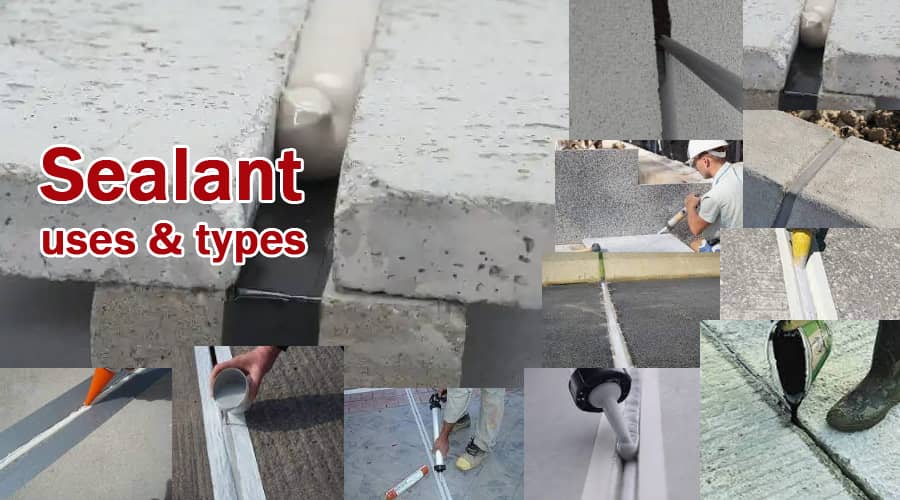Types and Uses of Sealant

Introduction
There are many different materials that must be linked to one another in order to build a house. Concrete, wood, metal, glass, fiberglass, and other materials are all used in structures and have their own uses.
However, because incompatible materials do not always make the tightest connections, the seams where these various materials could come together might be difficult to seal. Sealants, fortunately, are a distinct class of building materials created for the purpose.
What do you mean by a sealant?
The purpose of sealants is to prevent fluids, air, or pests from passing through gaps between building materials by sealing, blocking, or closing these gaps.
The materials used to seal these joints provide the ability to fill any irregularities that may arise between the two surfaces at the points where dissimilar materials meet. There is also the possibility of filling cracks in surfaces such as concrete, fiberglass, and other rigid building materials with sealants.
Typically, sealants are thick liquids or pastes that may be applied using a caulking gun. Users can also use a trowel to apply sealants, or they can apply the liquid to the junction before assembly, letting the sealant naturally adopt the shape of the gap as it is compressed.
Where should you use a sealant?
Sealants are often used in a range of applications. The rough opening will be caulked with a sealant by window and door installers, resulting in an airtight seal that improves the comfort of the residence. There may also be a sealant at the point where frame timber meets concrete foundations, however, in this instance, the sealant is often made of foam strips.
A sealant can also be used in other areas of the house, such as window glazing, patching cracks in concrete foundation walls and sidewalks, and sealing seams around molding in the home such as around shower and tub surrounds.
Whenever there is a small gap between two surfaces where water, air, or insects can pass through, a sealant might be the solution.
Varieties of sealants
There are several different sealants that may be used, and each has advantages and disadvantages. Some sealants are best suited for a particular use, meaning they might not be effective in other situations. Others could have a wider range of objectives. Because of this, it's critical to select the finest sealant for the specific job at hand.
Acrylic Sealants
Like latex, acrylic sealants may be painted, but their sealing qualities are often more stable and don't shrink as much. These sealants are ideal for outdoor applications that might need color matching, such as concrete cracks, trim around outside windows and doors, and other readily visible and weather exposed repairs since they are frequently paintable.
Butyl Sealants
This type of sealant is rubber based, and its adhesive properties are excellent. It adheres to a wide range of materials. There is a bit of runniness and stringiness to them, making the application messy. Due to the fact that they don't cure like other sealants, these sealants tend to be very flexible, have a long service life, and are resistant to UV rays, moisture, and aging.
Despite being highly water resistant, these sealants are not very stable, which makes them prone to tearing. In addition, they do not accept paint well.
Silicone Sealants
Despite their unpatentability, silicone sealants are excellent all around sealants. Water-resistant and very flexible, these products are ideal for outdoor use. They are also less prone to shrinking than most other sealants, and they stick to almost any material.
Apart from the fact that silicone sealants cannot be painted, silicone sealants are excellent all around sealants. In addition to being highly water-resistant, these products remain very flexible. As well as adhering to almost any material, they are less prone to shrinkage than most other sealants.
Polyurethane Sealants
A polyurethane-based sealant could be the best choice when it comes to a tough sealant that sticks to most surfaces. To prevent fluids from passing through joints, these sealants create strong bonds between materials.
They are also abrasion resistant and provide more flexibility than many other sealant types, making them a favorite in the construction industry. As a result of their abrasion resistance and flexibility, they are one of the most popular types of sealants in the construction industry as they are a great choice for many applications.
Polysulfide Sealants
In spite of the fact that polysulfide sealants are quite expensive and contain higher levels of volatile organic compounds (VOCs) than other sealants, they are extremely useful in certain applications.
As long as they remain flexible throughout their service life, they are an excellent choice for active leaks that need immediate repair. They can even be applied underwater, which makes them an excellent choice for leaks that need immediate attention.
Water Based Sealants
For sealing gaps between moldings, doors, and windows, water based sealants are popular in the construction industry. Applied and cleaned up easily, these sealants dry relatively quickly. Paint can also be applied to water-based sealants.
Since water based sealants have a lot of water in them, they tend to shrink when they are dry, which makes them unsuitable for use in wet or exterior environments.
